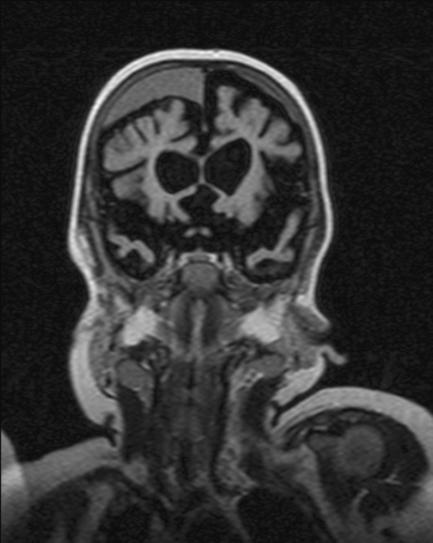A male infant presented at 3 months of age with status epilepticus. Magnetic resonance imaging (MRI) showed bilateral subdural haematomas with diffuse cerebral and cerebellar atrophy (fig 1), A radiological skeletal survey showed anterior flaring of the ribs and metaphysial spurs at the lower ends of the femur, ulna, and radius (fig 2).
Figure 1 Brain MRI coronal image showing bilateral subdural collections, the right much greater than the left in size, and diffuse cerebral and cerebellar atrophy.
Figure 2 Radiographs of knee and wrist showing metaphysial irregularity and spurring.
These findings could have raised the false suspicion of non‐accidental injury, but a detailed history, careful clinical examination, and the typical EEG findings facilitated the correct diagnosis.
The infant was born prematurely and developed neonatal jaundice and E coli septicaemia. Physical examination demonstrated scanty colourless hair (stubble) palpable on the scalp, high arched palate, pale lax skin, and marked hypotonia. Electroencephalographic (EEG) tracings included multi‐focal epileptiform discharges alternating between the hemispheres and hypsarrhythmia. Light microscopy of the hair demonstrated characteristic pili torti. Biochemical and genetic studies for Menkes disease were confirmatory.
Menkes disease is a rare metabolic disease, usually presenting within the first year of life. Failure to thrive, neurological deficits, and seizures, along with subdural haematomas and bony changes (rib and long bone fractures) are classical features of Menkes disease but also common findings in child abuse.1,2 Approximately 7% of children who have signs suggestive of abuse actually have an underlying medical condition that explains their injuries.3
It is important that the clinician does not misinterpret signs of Menkes disease and make the mistaken diagnosis of non‐accidental injury. Search for typical features of Menkes disease, absence of cutaneous injury, and retinal haemorrhage should enable the correct diagnosis.
Footnotes
Competing interests: None declared.
References
- 1.Kaler S G. Menkes kinky hair disease. http://www.emedicine.com
- 2.Tenney‐Soeiro R, Wilson C. An update on child abuse and neglect. Curr Opin Pediatr 200416233–237. [DOI] [PubMed] [Google Scholar]
- 3.Wardinsky T D, Vizcarrondo F E, Cruz B K. The mistaken diagnosis of child abuse: a three‐year USAF Medical Center analysis and literature review. Mil Med 199516015–20. [PubMed] [Google Scholar]




